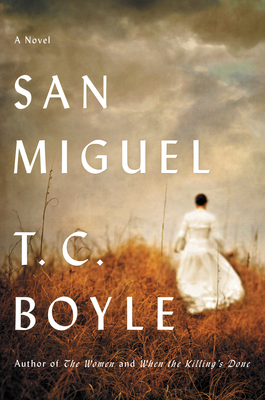T.C. Boyle’s new novel, “San Miguel,” is written to the natural rhythms of a distant, isolated place, and to the human rhythms of tormented souls.
San Miguel Island is a real place, the westernmost of the Channel Islands off the coast of Southern California. In Boyle’s book, it’s a patch of earth beyond the end of the Western frontier, a place where the mythical Western ethos makes its last stand.
“San Miguel” tells the story of the people who lived there in the final decade of the 19th century and the early decades of the 20th. They raise sheep, living an often-harsh existence amid seals, eagles and storms that sweep in from the Pacific.
Members of a single family and their occasional, transient employees, the residents of San Miguel tend to a ranch. They feel entirely isolated from most of the rest of the world, even though Santa Barbara is just a few hours away (by boat).
“San Miguel” is the prolific Boyle’s 14th novel. As always, he fills his pages with wonderfully precise character studies and lush descriptions of the physical landscape.
But “San Miguel” is perhaps too faithful to the true story of its protagonists to be a truly outstanding work of art. Many of Boyle’s characters in “San Miguel” feel marooned. And reading his account of their island lives can leave you feeling as if you’ve been cast adrift along with them.
Boyle’s protagonists are three women. These include the ill and irritable Marantha Waters, who arrives with her husband and daughter on New Year’s Day 1888. Ostensibly, Marantha’s there to recuperate from a consumptive lung disease that is killing her, one painful cough at a time.
Throughout his career, Boyle has shown a fascination with remote, forgotten places as a kind of stage where the various shadings of the American character are revealed. In the outstanding “World’s End,” it was the Hudson River Valley; in “East Is East,” an island off the coast of Georgia.
Marantha’s husband, Will, is a Civil War veteran. He brings his family to San Miguel just two years before the Census Bureau famously declared the American frontier closed. Like generations before him, Will is determined to make a go of it, the elements and the economy be damned.
Weeks turn into months as Marantha pines for cosmopolitan San Francisco, or even a decent meal in Santa Barbara. She scolds her willful daughter and pesters her husband for emancipation from her island prison. Sometimes this makes for compelling reading, and sometimes it doesn’t.
The novel gets a burst of energy in the second section, told from the point of view of Edith, Marantha’s teenage daughter.
The novel’s third section jumps ahead to 1930, when Elise and Herbie Lester arrive on the island. The newlyweds have the last stretch of the pure, unpopulated West to themselves. But here Boyle’s prose begins to lose its sense of urgency.
In the end, much of “San Miguel” feels like an elegant retelling of a collection of not-entirely-suspenseful diaries. It’s as if Boyle intended merely to bear witness to the lives of his characters, rather than to create art from their experiences. And yet, bearing witness requires craft too, and Boyle’s ample narrative gifts still make “San Miguel” worthwhile reading.
Copy the Story Link
Send questions/comments to the editors.



Success. Please wait for the page to reload. If the page does not reload within 5 seconds, please refresh the page.
Enter your email and password to access comments.
Hi, to comment on stories you must . This profile is in addition to your subscription and website login.
Already have a commenting profile? .
Invalid username/password.
Please check your email to confirm and complete your registration.
Only subscribers are eligible to post comments. Please subscribe or login first for digital access. Here’s why.
Use the form below to reset your password. When you've submitted your account email, we will send an email with a reset code.